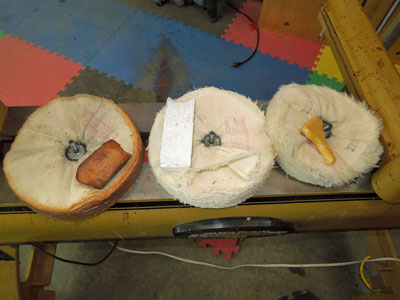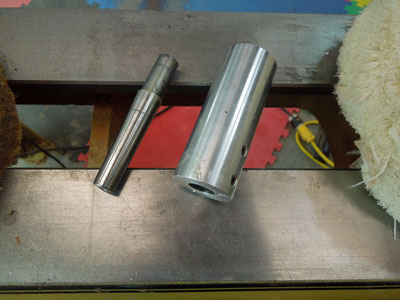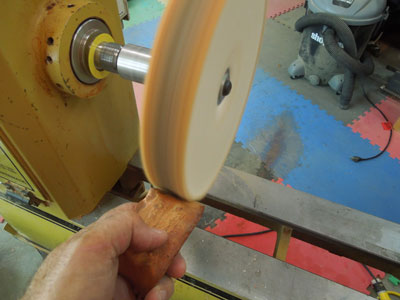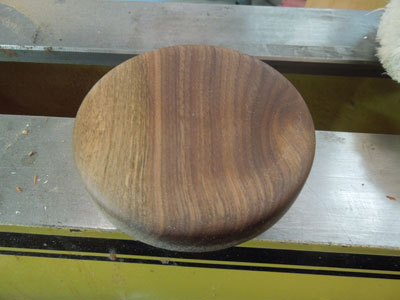Beall Wood Buff Kit - Tool Review
by Jeffrey Fleisher
New Market, VA
Click on any picture to see a larger version.
The Beall Wood Buff Kit
has gained popularity over the years because it is a quick and easy way to produce a high luster on your woodworking projects. The system uses two polishing compounds and Carnauba Wax to produce a very nice sheen and a food-safe surface, which is suitable for toys, kitchen tools or items that are going to hold food.
The Beall Tool Company was founded by J.R. Beall in 1982. J.R. Beall is a fine woodworker who began building musical instruments in 1969, making more than 800 dulcimers, hammer dulcimers, guitars, harpsichords and more. He continued as a professional woodworker for many years, during which time he built clocks, furniture, giant wooden tools and wooden machinery. The wood buffing kit is one of many products from The Beall Tool Company that are designed to improve your woodworking skills.
The wood buffing kit includes three 8" buffing wheels, two for the polishing compounds and one for the Carnauba Wax. It also includes a 1/2" - 5/8" combination adapter to attach the buffing wheels to your motor. The wood buffing wheels are similar to metal buffing wheels used by jewelers but with a much softer and looser weave so that they can conform to larger wood surfaces. Each wheel is labeled with the intended compound or wax...the Tripoli wheel is a moderately stiff all-linen fabric, the White Diamond wheel has linen plies interspersed with softer cotton ones and the Carnauba wax wheel is very soft and all cotton flannel fabric. Be sure to use the correct wheel for each type of compound.

|
The wheel shown on the left in the picture above uses a compound called Tripoli, the wheel in the center uses a compound called White Diamond and the wheel shown on the right uses Carnauba Wax. As you will see, they are used in that order as well. One end of the combination adapter, on the right in the picture, attaches to your motor shaft where it is held in place by set screws. The other end is internally threaded to accept the bolts installed in the center of each buffing wheel, enabling you to change wheels quickly during the buffing process.

|
The buffing wheels may be attached to a 1725 r.p.m. stationary motor, a wood lathe or any device that you can provide that will drive the wheels at this speed. A 3000 r.p.m. speed motor is too fast and should not be used. There are accessories available to connect the adapter to different devices. In my case, I use a #2 Morse Taper, shown on the left in the picture, that fits into the combination adapter and then fits into the headstock of my lathe. The Morse Taper is not provided in the basic kit and needs to be purchased separately.
Once you have the combination adapter attached to your motor it is very straight forward to use the buffing system. You start out by mounting the Tripoli buffing wheel and 'charge' it with the Tripoli buffing compound. This is done by holding the bar of compound against the spinning wheel for just a few seconds. You then place the object you want to finish against the spinning wheel.
To give you an idea of how this works, I created a small walnut disk that has a simple walnut oil finish applied to the surface, as shown in the picture. The walnut oil soaked into the walnut disk and has cured for a couple of days. The walnut oil catalyzes the wood fibers in the wood but doesn't really build any surface finish. The Beall buffing system will provide a nice sheen to the surface of the wood.

|
Starting out with the Tripoli wheel, place your wood piece against the spinning wheel and lightly buff the surface. One word of caution....hold on tight!! As you can imagine, the wheel is spinning at approximately 1725 r.p.m., so the wheel does have a tendency to want to grab the piece and turn it into a Frisbee for you. Luckily, as long as you are aware of this, it isn't too hard to hold onto and control your piece. Just hold the piece slightly below center of the spinning wheel so the wheel cannot grab the piece. I would normally use two hands, unlike what you see in the picture, but my other hand is busy holding the camera!

|
Once you have an initial polish with the Tripoli you repeat this same process with the White Diamond compound and the Carnauba Wax. The combination adapter makes it very easy to remove one buffing wheel and replace it with the next one. When you are done you will have a piece with a very nice polished surface. I did half of the walnut disk so that you could compare the before and after surfaces.
As you can see in the picture, the left side is the natural walnut oil finished surface while the right side has been buffed and has a very nice polished surface that is reflecting the light in my shop. Since the buffing process adds only a thin coat of Carnauba Wax, a non-toxic edible substance, this technique is a particularly good choice for toys or pieces which are intended to contain food items.
The buffing wheels require very little maintenance. Over time you may see a buildup of the Tripoli compound on the all-linen wheel. This can be easily removed with some course sandpaper mounted on a wood block. This doesn't need to be done very often and is never required on the White Diamond or Carnauba Wax wheels.
The system can be used on a variety of products. I've used it on bowls, pens and even plates that I have chip carved. Many of the woodturners in my local woodturning club use the buffing system as well. Since many woodturners use penetrating oil finishes such as Watco Danish oil, Behlen Tung oil and Mahoney Walnut oil this system will give them a beautiful protective sheen. If you use these types of finishes and want a nice protective finish that has a beautiful surface sheen, then I highly recommend the Beall Wood Buffing kit.
Watch a video demo of the Beall Wood Buff Kit
Find out more about the
Beall Wood Buff Kit
Jeffrey Fleisher has been a woodworker for approximately 20 years and a professional woodworker for the past 6 years. He is the president of his local woodturning club, the Woodturners of the Virginias and past president of the Northern Virginia Carvers. You can see some of the furniture he has made at www.jeffswooddesigns.com. He can be reached by email at furnmkr@gmail.com.
Return to
Wood News
front page
